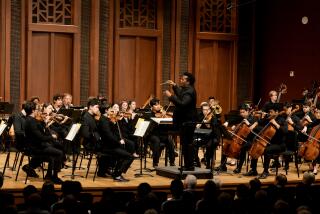PARTCH’S INSTRUMENTS AT GROSSMONT
- Share via
EL CAJON — The late Harry Partch was a rare individual. He didn’t go to Juilliard or to a prestigious art school. He was a self-taught man. But, by some, he is considered to have been a musical genius and a forerunner of performance art and minimalism.
Partch started as a composer and a keyboard player. In the middle of the 20th Century, he devised his own tuning system, in which he built special instruments to accommodate his theory. These sculptural art pieces are on exhibit at Grossmont College Art Gallery through Feb. 27.
The percussion and string instruments have not been exhibited since the 1960s, when they were shown at the the Whitney Museum of American Art and the San Francisco Museum of Art.
Danlee Mitchell, a music instructor at San Diego State University, met Partch in 1956 and became his assistant. Mitchell inherited the instruments when Partch died in 1974.
The artist’s instruments are aesthetic, often resembling found-object sculpture. They are constructed of wood, eucalyptus branches, bomb shells, gourds, bamboo and glass containers and bottles.
In a variety of shapes and sizes, Partch developed his own bizarre line of marimbas: “The Diamond Marimba,” “Quadrangularis Reversum,” “Bass Marimba,” “Liquor Bottle Marimba” and “Tube Marimba.” All five instruments were designed with function in mind, Mitchell said. Partch even painted numbers on the bars for tuning assistance.
“Partch based his tuning system on the natural principles of nature and the acoustics of the ear,” Mitchell said. “His scale utilizes 43 tones to the octave instead of the familiar 12-tone scoring system. He built his instruments with this in mind, setting up the bars in what he felt was their natural order. Our tuning system today is an arbitrary system that goes against nature.”
Some of the more unusual-looking instruments are the “Gourd Tree,” Japanese bells attached to gourds suspended from eucalyptus branches; “Cone Gongs” made from the nose cones of a fuel tank from a jet fighter, and the “Cloud-Chamber Bowls,” cut-off chemical bottles suspended by wire from a wood frame.
Partch thought that music should be a very visual experience, and saw the change in performance dynamics in the 1950s with Elvis Presley, Mitchell said. He was also an enthusiast of African, Greek and American Indian music.
“Partch was a passionate believer in the use of music as a corporeal experience, where sight and sound combine to evoke a heightened physical, emotional and intellectual impact on the viewer,” Mitchell said.
The massive instruments have influenced several musicians, including local performance artist Arthur Frick, Mitchell said. Like Frick, Partch’s performance pieces were animated and special musical scores were rewritten for the instruments. However, Mitchell said that Partch was never really given the proper chance to do a big performance.
For that reason, in 1972, Mitchell founded the Harry Partch Ensemble, a troupe of mimes, dancers, thespians and musicians who are specially trained to play the instruments. They have made two West Coast tours, participated in the Aspen Festival and performed in the Berlin Festival. Video recordings of their performances are at the gallery.
With exhibitions and shows put on by the ensemble, Mitchell has managed to preserve Partch’s musical theory and pass it on.
More to Read
The biggest entertainment stories
Get our big stories about Hollywood, film, television, music, arts, culture and more right in your inbox as soon as they publish.
You may occasionally receive promotional content from the Los Angeles Times.










